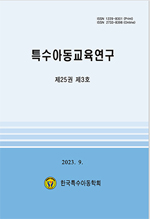- 영문명
- An Analysis on Nonverbal Communicative Behavior Used by Special Education Teachers in Instruction
- 발행기관
- 한국특수아동학회
- 저자명
- 김지민(Ji-Min Kim) 최상배(Sangbae Choi)
- 간행물 정보
- 『특수아동교육연구』제27권 제3호, 133~151쪽, 전체 19쪽
- 주제분류
- 사회과학 > 교육학
- 파일형태
- 발행일자
- 2025.09.30

국문 초록
연구목적: 이 연구의 목적은 특수교사가 사용하는 비언어적 의사소통 행동을 분석하고 이를 유형화한 뒤, 그 빈도와 비율을 정리함으로써 특수교사 수업에 대한 이해를 돕고 후속 연구의 기초자료를 제공하고자 하였다. 분석을 위하여 6명의 특수교사 수업을 선정하였고 각 수업의 분량은 30분이었으며, 분석에 사용한 총 수업 영상은 180분 분량이었다. 비언어적 의사소통 행동은 제스처, 시선, 신체접촉, 표정이었다. 연구결과: 특수교사 수업에서 비언어적 의사소통 행동 요소는 모두 1,060회 관찰되었으며, 시선(40.3%), 제스처(36.5%), 표정(16.5%), 신체접촉(6.7%) 순으로 많이 사용되었다. 제스처에서는 지시적 제스처 50.1%, 표상적 제스처 33.9%, 관습적 제스처 16.0%의 순서로 많이 사용되었다. 시선은 교사의 의도와 정서를 반영하여 의미를 전달하며 고정 45.9%, 둘러보기 42.2%, 공동집중 응시 11.9%의 순서로 사용되었다. 신체접촉은 교사와 학생 사이 긍정적 관계 형성의 역할을 하며 학습접촉 53.5%, 안정접촉 32.4%, 칭찬접촉 14.1%의 순서로 사용되었다. 표정은 시각적으로 교사의 감정, 태도, 수업 의도 등의 의미를 전달하며 미소 42.3%, 꾸밈연기 33.7%, 찡그림 24.0%의 순서로 사용되었다. 결론 및 제언: 이러한 주요 연구 결과를 바탕으로 연구의 시사점과 향후 특수교사 수업의 비언어적 의사소통 행동 분석 내용과 방법을 제안하였다.
영문 초록
Purpose: The purpose of this study was to analyze and categorize the types of nonverbal communication behaviors used by special education teachers and to examine their frequency and proportion. Method: The study analyzed 30-minute class segments from six special education teachers, totaling approximately 180 minutes of classroom instruction. Four types of nonverbal communication behaviors were examined: gestures, eye gaze, physical contact, and facial expressions. Results: A total of 1,060 nonverbal behaviors were observed. Among them, eye gaze was the most frequently used (40.3%), followed by gestures (36.5%), facial expressions (16.5%), and physical contact (6.7%). Within the category of gestures, deictic gestures accounted for 50.1%, representational gestures for 33.9%, and conventional gestures for 16.0%. Eye gaze conveyed the teacher’s intentions and emotions, with fixed gaze (45.9%), looking around (42.2%), and joint attention (11.9%) being the most common. Physical contact was used to promote positive teacher-student relationships, with instructional touch (53.5%), comforting touch (32.4%), and compliment touch (14.1%) observed. Facial expressions conveyed emotions, attitudes, and instructional intentions visually, with smiling (42.3%), performed expressions (33.7%), and frowning (24.0%) being the most prevalent. Conclusion: Based on these findings, this study discusses implications and proposes directions for future research on nonverbal communication behaviors in special education classrooms.
목차
Ⅰ. 서 론
Ⅱ. 연구 방법
Ⅲ. 연구 결과
Ⅳ. 논의 및 제언
참고문헌
키워드
해당간행물 수록 논문
참고문헌
최근 이용한 논문
교보eBook 첫 방문을 환영 합니다!

신규가입 혜택 지급이 완료 되었습니다.
바로 사용 가능한 교보e캐시 1,000원 (유효기간 7일)
지금 바로 교보eBook의 다양한 콘텐츠를 이용해 보세요!


